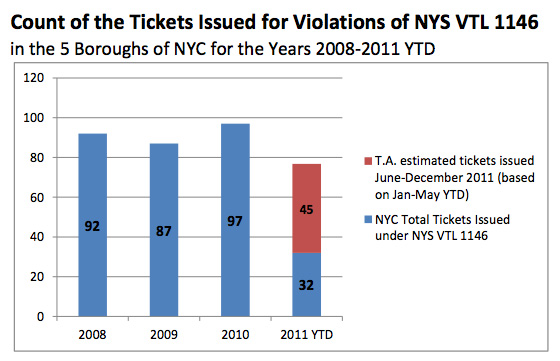In 2010, State Senator Dan Squadron and Assembly Member Brian Kavanagh stood on the corner of Essex and Delancey Streets to tell motorists: "Careless driving is unacceptable." Said Kavanagh, "You can suffer serious consequences."
A year later, however, the new enforcement tool the two legislators were touting, Hayley and Diego's Law, had gone almost entirely unenforced. Intended to offer law enforcement an intermediate option between simple moving violations and serious criminal charges, the law hasn't proved as useful as hoped.
Now, Squadron and Kavanagh are back with an amendment to Hayley and Diego's Law intended to help police and prosecutors put it to use.
"Hayley and Diego's Law made it clear that a driver's license is not a license for carelessness," said Squadron. "But we now must provide law enforcement with additional tools to effectively crack down on careless driving."
Based on conversations with district attorneys and police officers, the law's sponsors and Transportation Alternatives found a police protocol they believe to be a key obstacle to bringing charges of careless driving. "Unless a cop witnesses a violation, they cannot write the ticket," said T.A. general counsel Juan Martinez.
Squadron and Kavanagh's new law would make it explicit that police can make arrests under Hayley and Diego's Law without having directly witnessed a violation, assuming officers have reasonable cause to make the arrest.
Said Kavanagh, "Now with the benefit of our experience of how the law is working in the field, we’ve worked with law enforcement and safety advocates and identified a way to make it far more effective at holding careless drivers accountable for their dangerous behavior and making our streets safer.”
The current problem, said Martinez, is the intermediate status of Hayley and Diego's Law. Though it's intended to be more serious than a traffic violation, legally it's lumped in with other moving violations, which is how police have treated it so far. "Nobody wants the police to be out there writing tickets for ordinary traffic violations they didn't see," said Martinez, citing red-light running as an example.
Hayley and Diego's Law only applies to crashes that injure a pedestrian or cyclist, not careless driving in general. "There are often several witnesses who want to say, 'This is what I saw happen,'" said Martinez. "It's a different kind of violation."






